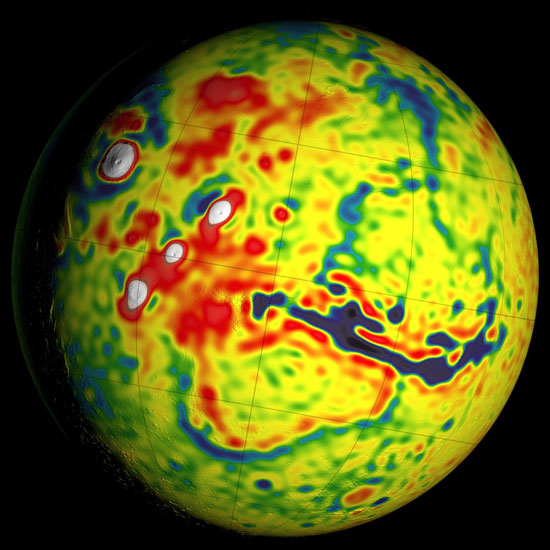
Did Fermi Detect LIGO’s Merging Black Holes?
NASA’s Fermi Gamma-ray Space Telescope might have detected a burst from the same merging black holes that emitted the gravitational waves LIGO detected.

Saturn Moons Could Be Young
Planetary scientists have increasing reasons to think that some of the ringed giant’s moons are only 100 million years old.

Mars Gravity Map
By tracking deviations in spacecraft orbits, planetary scientists have created a high-resolution map of the Red Planet's gravitational pull.

Super Spiral Galaxies
Astronomers have identified 53 “super spirals” — spiral galaxies that are huge and incredibly luminous — as part of a project exploring archived observations.

Flood Threatens Photographic Plates
A burst pipe flooded Harvard College’s Observatory Hill, submerging thousands of historic photographic plates underwater. Recovery is now under way.

Exoplanet in the Hyades Star Cluster
Professional and amateur astronomers working together have found a young exoplanet in the Hyades star cluster. The planet is weirdly large, given its host star.

Galaxies Hidden Behind the Milky Way
Astronomers have detected hundreds of galaxies lying hidden behind the Milky Way's disk, many of which belong to the so-called Great Attractor, or Norma Supercluster.

Dark Matter Makes Galaxy Clusters Clump
How much galaxy clusters huddle together depends in part on how fast these clusters formed — and that formation rate depends on dark matter.

Giant Cloud Came from the Milky Way
The massive Smith Cloud falling toward our galaxy’s disk is likely from our galaxy, not a visitor.

Old Stars' Fossil Fields
Astronomers have confirmed that strong magnetic fields are frozen in place deep inside aging stars called red giants.

Spotting "Twins" of Superstar Eta Carinae
Astronomers looking for clones of a massive and famously unstable star in the Southern Hemisphere sky have found five in other galaxies.

NASA's Plans for Putting Humans on Mars
Scientists and engineers gathered together to figure out what would make a good Martian landing site and what hurdles they’ll have to overcome for a 2035 launch.

Newborn Star Puts on Star Wars Show
Infrared observations by the Hubble Space Telescope reveal jets from forming stars.

Our “Magnetic” Black Hole
Astronomers have detected magnetic fields writhing around the Milky Way's central black hole.

Astronomers Take Galaxy’s Pulse
Astronomers have caught a giant elliptical galaxy “shimmering” as its stars pulsate.

Pulsars' Gamma Rays Highlight Mysteries
The Fermi Gamma-ray Space Telescope has discovered that almost all of the highest energy photons in the Large Magellanic Cloud come from two pulsars.

Mars Losing Gas to Solar Wind
NASA’s Mars orbiter MAVEN has painted a detailed picture of how the solar wind robs the Red Planet of its atmosphere.

How a Black Hole Flares
X-ray observations suggest that flares happen when a black hole's "atmosphere" contracts and launches away from it.

Small Galaxies Helped Light Up Universe
Hubble observations confirm that much of the light that broke up the early universe’s hydrogen came from the smallest galaxies.

Cassini Flies Through Enceladus's Plume
On October 28th, the Cassini spacecraft took its deepest dive through the water plume spewing from the south pole of Saturn’s moon Enceladus. It passed only 30 miles (50 kilometers) above the icy surface.
